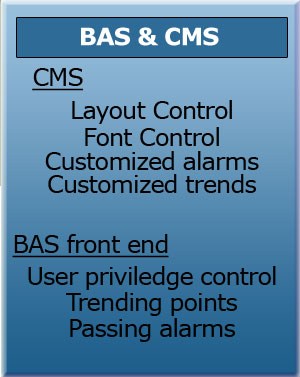September 2007
![]()
AutomatedBuildings.com
[an error occurred while processing this directive]
(Click Message to
Learn More)
September 2007 |
[an error occurred while processing this directive] |
|
|
Alper Uzmezler |
68% percent of Americans surf the web daily. We shop, read news, watch videos, exchange stock, read articles about the industry.
|
|
|
|
|
|
|
|
|
|
|
|
|
|
|
|
|
|
|
|
|
[an error occurred while processing this directive] |
The common knowledge of visiting websites is being used for the B.M.S. with various front end tools. (Building management systems) In the near future, it will be common for B.A.S. creators to have knowledge in C.S.S. (Cascading Sheet Styles), HTML (Hyper Text Mark Language), and JavaScript and DOM for Browsers.
When front ends converge to regular standards of web design, we will see the familiar mistakes and pluses. BMS front ends should follow these trends for ease of use for the customer.
Let’s compare the common mistakes in web design trends in 90’s and see familiarities in building automation.
1) Colors usage in designs in the early 90’s
a. Misuse of gradients
b. Extremely flashy graphics
2) Web trends in the 2000’s
a. What is color theory? Why we should follow in our gui’s?
b. What parts we should follow in these systems?
c. What does future hold for us in GUI experience? CMS
Colors
Using the right colors for GUI is crucial. Misuse of colors can cause distraction to the front–end user. What should GUI creators avoid doing?
Do not use shiny colors (Try to use pastel colors)
Do not over use gradients. Example of over used gradients http://www.blinksale.com/home
Do not create excessive animations. Only animate equipment that is important such fans, coils and dampers for air handling units. Do not create animations temperature sensors which can distract users.
Color theory
[an error occurred while processing this directive] The use of color theory can be daunting but there is a program that simplifies the process. The program is called color wheel pro and can be downloaded at http://www.color-wheel-pro.com/
“Color Theory is a set of principles used to create harmonious color combinations. Color relationships can be visually represented with a color wheel — the color spectrum wrapped onto a circle”. (Cited from color wheel pro website)
“In the arts of painting, graphic design, and photography, color theory is a body of practical guidance to color mixing and the visual impact of specific color combinations. Although color theory principles first appear in the writings of Alberti (c.1435) and the notebooks of Leonardo da Vinci (c.1490), a tradition of "colory theory" begins in the 18th century, initially within a partisan controversy around Isaac Newton's theory of color (Opticks, 1704) and the nature of so-called primary colors. From there it developed as an independent artistic tradition with only sporadic or superficial reference to colorimetry and vision science.” (Cited from Wikipedia)
Importance of CSS and the use in automation industry
What are cascading sheet styles?
Cascading sheet styles are used to normalize the look of web pages efficiently. It has been adopted by a few automation front ends which gives us the power of this standard. With this programming language, we can easily edit font sizes, colors and layouts. So far the industry has seen text editing with CSS but layout options have not been implemented to the automation front-ends. It will be revolutionary to add CSS layouts.
 When
will the automation GUI will converge with websites?
When
will the automation GUI will converge with websites?
Latest trends in web design have been content management systems. There are various application commercial or GPL licensed that can be downloaded.
What is a content management system?
“A Content Management System (CMS) is a software system used for content management. Content management systems are deployed only for interactive use by a potentially large number of contributors. For example, the software for the website Wikipedia is based on a content management system” (Cited from Wikipedia)
Why CMS should converge with automation industry?
CMS is not only a great tool to optimize layouts and designs but also has immense capability to distribute information with style. The BMS industry is looking for new ways to improve passing information to the customers. CMS ‘s can be used to create views for companies that require uniformity throughout their systems. In the future, I hope that automation industry manufacturers will follow CMS applications and come up with products that are easier to use and edit.
A List of CMS application can be found at Wikipedia
Joomla – http://www.joomla.org
Drupal – http://www.drupal.org
Word press – http://www.wordpress.org
CMS applications use CSS in an efficient manner to create front-ends.
[an error occurred while processing this directive]
[Click Banner To Learn More]
[Home Page] [The Automator] [About] [Subscribe ] [Contact Us]